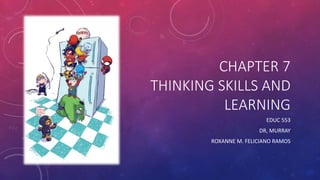
EDUC 553: Souza Chapter 7
- 1. CHAPTER 7 THINKING SKILLS AND LEARNING EDUC 553 DR, MURRAY ROXANNE M. FELICIANO RAMOS
- 3. INTRODUCTION • Discuss the characteristics and dimensions of human thinking. • Revising Bloom’s Taxonomy. • Relationship between difficulty, complexity, and intelligence.
- 4. CHARACTERISTICS OF HUMAN THINKING What is thinking? • How and when we use these aspects often determine our success and/or failure on interactions. Types of Thinking Information Recall Categorize Analyze Synthesize Processing Summarizing Thinking Developing concepts Solving Problems Intuition Anticipating The Future Learning Memory Using Words Creativity
- 5. THINKING AS A REPRESENTATIONAL SYSTEM • The word itself is not actually that concept, but it brings forth many associations having to do with that word. • It is this recognition of diversity that has led to the notion of multiple intelligences. • Thinking patterns vary when encountering different challenges. • These semiautonomous variations in thinking result in different degrees of success in learning. Beach Things Associated Imagery Experiences
- 6. Thinking and Emotion • Emotions can impede or assist cognitive learning. When we like something, we are more likely to maintain attention and interest in the subject, and move to higher level thinking. VS. When we dislike something, we usually spend the least amount possible on the subject and stay at minimal processing level. Create activities that promote higher order thinking. Help students recognize the power their own thinking has at the moment of problem solve. Technology May Be Affecting How Students Think Information Avoidance Dependence of Internet Losing their Critical Thinking Skills
- 7. THE DIMENSION OF HUMAN THINKING Assessing conclusions based on observations Forming Conclusions based on patterns Finding patterns and generalizing Observing BASIC PROCESSES The tools we use to transform and evaluate information. These conclusions should be based on evidence, and help us: - We form patterns that help us hypothesize, infer, and predict.
- 8. THE DIMENSION OF HUMAN THINKING Domain-specific knowledge • Knowledge in a particular content area Critical thinking • Making judgments using objective criteria and offering opinion with reasons. Creative thinking • Putting together information to arrive at a whole new concept, idea, or understanding. Metacognition • The awareness one has of one’s own thinking process. • Monitoring progress while learning and making necessary changes. Creative Thinking has FOUR STAGES: - Preparation - Incubation - Illumination - Verification
- 9. Bloom’s Taxonomy (1956) Bloom’s Taxomony (2000) Knowledge Comprehension Application Analysis Synthesis Evaluation Remember Understand Apply Analyze Evaluate Create VS.
- 10. LEVEL SKILLS TERMS Create Putting together parts to form a new plan. Forming new patterns and structures. Imagen, compose, design, infer Evaluate Judge the value of information based on specific criteria. Appraise, asses, judge, critique Analyze Breaking components down so material can be understood. Analyze, contrast, distinguish, deduce Apply Use learned material in new situations with minimum of directions. Practice is essential in this level. Practice, calculate, apply, execute Understand Converting the material from one form to another, by interpreting the material, or by estimating future trends. Summarize, discuss, explain, outline Remember Rote recall and recognition of previously learned material. Define, label, recall, recognize
- 11. IMPORTANT CHARACTERISTICS OF THE REVISED MODEL Original Model Six levels were cumulative Focuses on the cognitive way of learning Revised Model Flexibility to overlap levels Other ways to view the levels. Convergent & Divergent Emotional thinking
- 12. CONNECTING COMPLEXITY AND DIFFICULTY TO ABILITY Complexity Through Process that brain uses to deal with information Difficulty Amount of effort that the learner must expend within a level of complexity to accomplish an objective.
- 13. OTHER THINKING SKILLS PROGRAMS Habits of Mind • Created by Arthur Costa and Bena Kallick • Looks at the characteristics that people demonstrate trying to solve problems. • It has identified 16 characteristics, such as: thinking with empathy, thinking about thinking, striving for accuracy, and others.
- 14. OTHER THINKING SKILLS PROGRAMS Understanding by Design (UBD) • Created by Grant Wiggins and Jay Mcthighe • Based on two main ideas: • Focuses on teaching and assessing for deep understanding and for transfer of learning. • Designing curriculum backward from those outcomes. • They propose six facets which include: • empathy that demonstrates the ability to walk in another’s shoes,
- 15. OTHER THINKING SKILLS PROGRAMS Webb’s Depth of Knowledge (DoK) • Created by Norman Webb • Suggests a four level model which is essentially a collapsed model of Blooms six levels.
